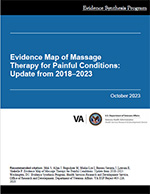
|
Recommended citation: |
Download PDF: Complete Report, Executive Summary, Report, Appendices
For painful conditions of priority to the VA that currently do not have at least moderate-certainty evidence supporting use of massage therapy, more high-quality randomized controlled trials that address limitations of existing research are needed to provide a stronger evidence base to assess the effect of massage therapy for pain. Studies comparing massage therapy to placebo or sham are probably not the priority; rather the priority should be studies comparing massage therapy to other recommended/accepted/active therapies for pain.
Massage therapy is a popular and widely accepted complementary and integrative health (CIH) modality for individuals seeking relief from pain. Despite its popularity and long history in practice, evidence of beneficial effect of massage therapy remains limited. The last ESP evidence map of massage therapy for pain was published in 2016 with an accompanying review article published in 2019. We conducted an update of a previous report and present a new evidence map of massage therapy for pain.
Our search included 5 databases with search dates from July 2018 to April 2023. We identified 1,164 potentially relevant citations and included 15 publications in this map. From these, 6 reviews describing conditions (e.g., chronic low back pain, fibromyalgia, myofascial pain) had moderate certainty of evidence for beneficial effect of massage therapy for pain. Evidence about adverse events were collected by about half of the included reviews and no serious adverse events were reported. While 9 of 15 reviews described adverse events, only 2 reviews included certainty of evidence conclusions for adverse events. Although the number of conclusions about the effectiveness of massage therapy that were judged to have at least moderate certainty of evidence is greater now than in 2018, it is still small relative to the need.
Evidence Map of Massage Therapy for Painful Conditions: Update from 2018-2023 (Management eBrief)
Mak S, Allen J, Begashaw M, et al. Use of Massage Therapy for Pain, 2018-2023: A Systematic Review. JAMA Network Open. 2024; 7(7):e2422259. DOI: https://doi.org/10.1001/jamanetworkopen.2024.22259.